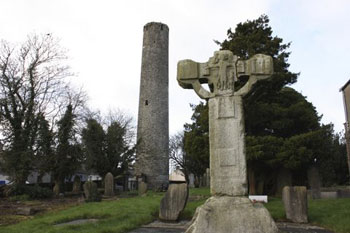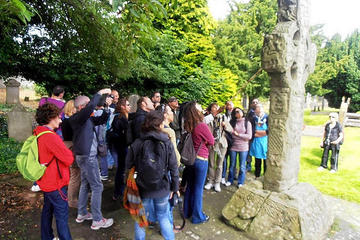
Ireland and Scotland
by Troy Herrick
After six years, I arrived in Dublin under gray overcast skies. The quest was about to be completed; the circle was about to be closed and loose ends tied together. With the Indiana Jones theme playing in my mind, I was all set to gaze upon the most decorated manuscript to survive from the Early Middle Ages in Europe – the Book of Kells.
Old Library, Trinity College Dublin – 2012
 Anticipation slowly rose as I traversed each room, stopping to read every detail about this holy book and its convoluted history. Entering the dimly lit Treasury Room at the end of the hall, I discovered four books displayed inside a glass case. The Book of Kells, divided into two tomes, was accompanied by the Book of Durrow and the Book of Armagh. Clearly the jewel in the crown was the four Gospels assembled into the Book of Kells.
Anticipation slowly rose as I traversed each room, stopping to read every detail about this holy book and its convoluted history. Entering the dimly lit Treasury Room at the end of the hall, I discovered four books displayed inside a glass case. The Book of Kells, divided into two tomes, was accompanied by the Book of Durrow and the Book of Armagh. Clearly the jewel in the crown was the four Gospels assembled into the Book of Kells.
Visitors see four vellum pages of this ancient manuscript – one volume open at a major decorated page and the other open to show two text pages with smaller decorations. As I studied the detail of each image with naked eye, I wished that I had a magnifying glass to better appreciate the complexity of design. I envisioned cross-eyed monks drawing each image using only a quill.
As many as ten different colours have been utilized in these illustrations. Many of these pigments had been imported from the farthest corners of the world almost 1200 years ago. The lapis lazuli in particular came from the area that is now present-day Afghanistan. One can only imagine the exorbitant cost of these paints given that this region of Europe was at the end of the trade routes. Furthermore the island of Iona in Scotland, where work on the Book of Kells began, was quite isolated at that time. Suddenly I had a flashback to the island of Iona in Scotland.
Iona, Scotland – 2006
 A chilly wind and a gray overcast sky greeted Diane and me as we set foot on Iona, the birthplace of Christianity in Scotland. St Columba (Colmcille) and twelve companions founded the first monastery here in 563 CE. Almost nothing remains of that original settlement because it had been replaced by St. Mary’s Cathedral, a Benedictine abbey church dating to 1200 CE. You might be surprised to find that this is a working abbey today, operated by an ecumenical community known as the Iona Commonwealth.
A chilly wind and a gray overcast sky greeted Diane and me as we set foot on Iona, the birthplace of Christianity in Scotland. St Columba (Colmcille) and twelve companions founded the first monastery here in 563 CE. Almost nothing remains of that original settlement because it had been replaced by St. Mary’s Cathedral, a Benedictine abbey church dating to 1200 CE. You might be surprised to find that this is a working abbey today, operated by an ecumenical community known as the Iona Commonwealth.
Set outside the abbey church to the left of the front door, you find a little greyish brown stone building known as St. Columba’s Shrine. Reconstructed in 1962, the lower portion of this structure may date to the 8th century. Tradition holds that St. Columba’s relics were once housed in this structure (he died in 597 CE and his relics were divided between Scotland and Ireland).
 A short distance in front of St. Columba’s Shrine, you find St. John’s Cross. This is a copy of an 8th century high cross displayed in the nearby Monks’ Infirmary now serving as a museum. The original cross was painstakingly reconstructed from fragments found on site. Another item of note in the museum is St. Columba’s Pillow, a stone with a ringed cross carved into it. This treasure is stored inside a small metal cage. There is no proof that the saint’s head ever rested on this pillow however.
A short distance in front of St. Columba’s Shrine, you find St. John’s Cross. This is a copy of an 8th century high cross displayed in the nearby Monks’ Infirmary now serving as a museum. The original cross was painstakingly reconstructed from fragments found on site. Another item of note in the museum is St. Columba’s Pillow, a stone with a ringed cross carved into it. This treasure is stored inside a small metal cage. There is no proof that the saint’s head ever rested on this pillow however.
Also associated with 8th century Iona is the Book of Kells. Columban monks began transcribing the Gospels around the year 800 CE but never completed them on site. The monks were displaced from Iona in 802 CE when Vikings torched the monastery. Returning to Ireland accompanied by their precious work-in-progress, the monks settled in Kells in 804 CE to re-establish another Columban monastery founded by the saint in 550 CE. Almost twelve centuries later, Diane and I followed them to the Emerald Isle and Kells.
Kells, County Meath, Ireland – 2012
 It was déjà vu all over again; a chilly wind and a gray overcast sky greeted Diane and me at St. Columba’s Church in Kells. This church, set on the site of the original Monastery of Kells, dates to 1778. The churchyard also contains a number of high crosses and a 26-meter round tower all dating back to the early monastic period and the arrival of the Book of Kells.
It was déjà vu all over again; a chilly wind and a gray overcast sky greeted Diane and me at St. Columba’s Church in Kells. This church, set on the site of the original Monastery of Kells, dates to 1778. The churchyard also contains a number of high crosses and a 26-meter round tower all dating back to the early monastic period and the arrival of the Book of Kells.
Round towers were a symbol of a monastery’s power in early Ireland, often serving as bell towers and repositories for sacred items. At the same time, the “conspicuous” towers identified monasteries as attractive targets for the pagan Vikings. The Norsemen raided the monastery at Kells several times during the 10th century.
During times of attack, the monks retreated inside the round tower through an entrance 3-4 meters off the ground and then pulled up the ladder. Paradoxically these towers do not appear to be very defensible because all the Vikings had to do was build a large fire below the doorway and smoke the occupants out.
History does not record that the Book of Kells was ever part of any Viking booty but it was stolen by the locals in 1009 from a small church that once existed in the churchyard. The book was eventually recovered but the cover was damaged beyond repair and had to be replaced.
 Learning their lesson, the monks constructed St. Colmcille’s House across the street from the present day churchyard as a more secure location for their precious manuscript and the relics of St. Columba. This dimly lit, empty stone building served as a monk’s dwelling and a scriptorium. The monk’s sleeping quarters in the loft above is still accessible by ladder.
Learning their lesson, the monks constructed St. Colmcille’s House across the street from the present day churchyard as a more secure location for their precious manuscript and the relics of St. Columba. This dimly lit, empty stone building served as a monk’s dwelling and a scriptorium. The monk’s sleeping quarters in the loft above is still accessible by ladder.
The holy book remained in Kells for over 800 years until 1653 when it was transferred to Trinity College in Dublin. Since the mid 19th century, the Book of Kells has been on public display in the Old Library and now Diane and I had the opportunity to see this historical treasure in Dublin and complete the quest.

Boyne Valley Hill of Tara and Kells Private Tour from Dublin
If You Go:
The Book of Kells Exhibition is located in the Old Library at Trinity College in Dublin. Admission was 9 Euros. Check out the Trinity College website for more details. Visitors are not permitted to photograph the Book of Kells.
Purchase the Heritage Island Tour Guide at the nearest Tourist Information Office for a discounted admission to the Book of Kells exhibit. www.heritageisland.com
Admission to Iona Abbey is £4.70
St. Columba’s Church of Ireland is located on R 163 in the center of Kells, just west of the intersection of N3 and N52. Admission to the churchyard is free.
St. Colmcille’s House – for admission, follow the directions provided on the gate. Admission is free but a tip is customary. For more information about Ireland, visit www.plan-a-dream-trip.com/discover-ireland.html. and Scotland, visit www.plan-a-dream-trip.com/scotland-tours.html Plan your vacation at: www.plan-a-dream-trip.com
Photographs:
All photographs are by Diane Gagnon. A freelance photographer, she has traveled extensively in North America, the Caribbean, Europe and parts of South America.
Contributor’s Bio:
Troy Herrick, a freelance travel writer, has traveled extensively in North America, the Caribbean, Europe and parts of South America. His articles have appeared in Live Life Travel, International Living, Offbeat Travel and Travels Thru History Magazines. He also penned the travel planning e-book entitled ”Turn Your Dream Vacation into Reality: A Game Plan for Seeing the World the Way You Want to See It” – www.thebudgettravelstore.com/page/76972202 based on his own travel experiences over the years. Herrick’s articles are in Live Life Travel, Offbeat Travel and Travel Thru History magazines.



Leave a Reply
You must be logged in to post a comment.